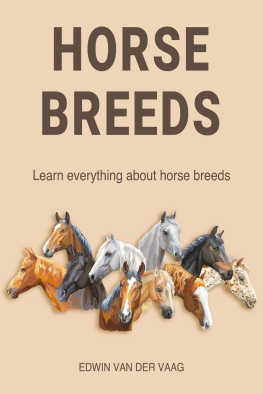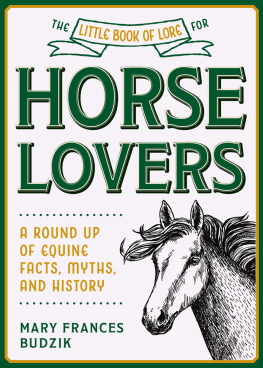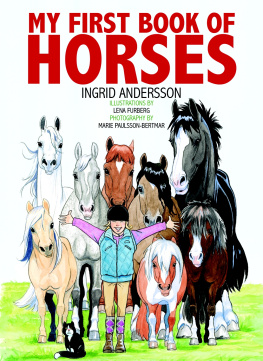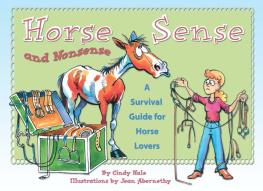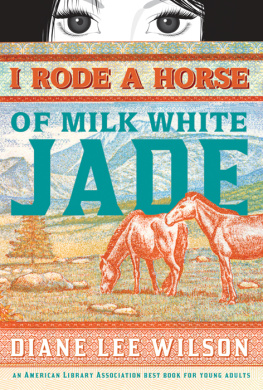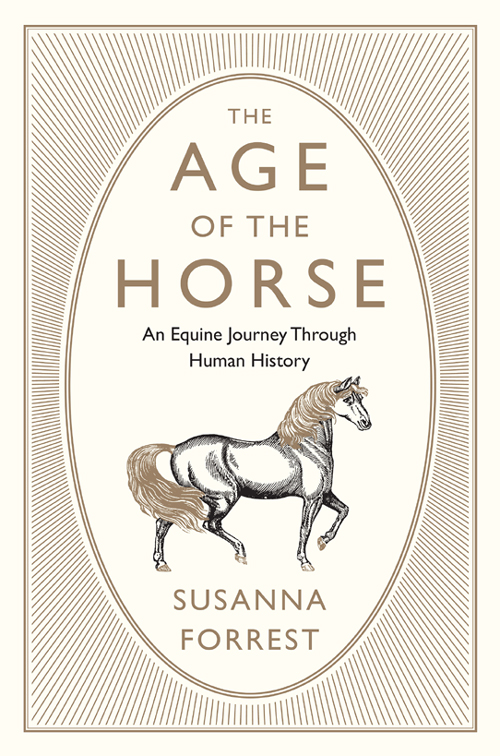THE
AGE
OF THE
HORSE
An Equine Journey Through
Human History
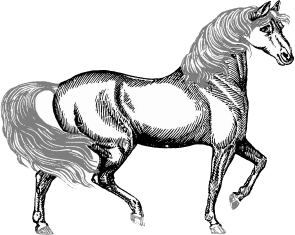
SUSANNA
FORREST

Copyright 2016 by Susanna Forrest
Cover design by nathanburtondesign.com
All rights reserved. No part of this book may be reproduced in any form or by any electronic or mechanical means, including information storage and retrieval systems, without permission in writing from the publisher, except by a reviewer, who may quote brief passages in a review. Scanning, uploading, and electronic distribution of this book or the facilitation of such without the permission of the publisher is prohibited. Please purchase only authorized electronic editions, and do not participate in or encourage electronic piracy of copyrighted materials. Your support of the authors rights is appreciated. Any member of educational institutions wishing to photocopy part or all of the work for classroom use, or anthology, should send inquiries to Grove Atlantic, 154 West 14th Street, New York, NY 10011 or .
First published in Great Britain in 2016 by Atlantic Books, an imprint of Atlantic Books Ltd.
First Grove Atlantic hardcover edition: May 2017
Published simultaneously in Canada
Printed in the United States of America
ISBN 978-0-8021-2651-1
eISBN 978-0-8021-8951-6
Atlantic Monthly Press
an imprint of Grove Atlantic
154 West 14th Street
New York, NY 10011
Distributed by Publishers Group West
groveatlantic.com
17 18 19 20 10 9 7 6 5 4 3 2 1
For Henry
FIRST COLOUR SECTION
(Lionel Bonaventure/AFP/Getty Images)
(Fine Art Images/Heritage Images/Getty Images)
(The Israel Museum, Jerusalem, Israel/Vera & Arturo Schwarz Collection of Dada and Surrealist Art/Bridgeman Images)
(Culture Club/Getty Images)
(Private Collection/Bridgeman Images)
(Ernst Sandau/ullstein bild via Getty Images)
(NaturfotoHonal/Getty Images)
(DEA Picture Library/Getty Images)
, c. 13751400 (Picturesfrom History/Bridgeman Images)
, c. 1721 (Imagno/Getty Images)
, c. 1846, from Histoirede lart dramatique en France depuis vingt-cinq ans by Thophile Gautier, 1859 (BibliothqueNationalde France)
by J. Delton, 1910 ( Victoria and Albert Museum, London)
, London, 2011 (Peter Macdiarmid/Getty Images)
, 2011 (Hubert Fanthomme/Paris Match via Getty Images)
(The Print Collector/Print Collector/Getty Images)
(17851857) ( National Museumsof Scotland/Bridgeman Images)
SECOND COLOUR SECTION
(180377) (Private Collection/ The British Sporting Art Trust/Bridgeman Images)
, 1880s (MaryEvans Picture Library)
(Private Collection/Lookand Learn/PeterJackson Collection/Bridgeman Images)
, Oregon, 1996 (AP Photo/Don Ryan)
, 1903 (Fotografisches Atelier Ullstein/ullstein bildvia Getty Images)
, 1943 (Bettmann/Getty Images)
( Zoonar GmbH/Alamy StockPhoto)
(Werner Forman/Universal Images Group/Getty Images)
, 1758 ( Beijing EastphotoStockImages Co., Ltd/Alamy)
, China, 1998 (SipaPress/REX/Shutterstock)
132535 ( BritishLibrary Board. All Rights Reserved/Bridgeman Images)
, 2014 (LuisRobayo/AFP/Getty Images)
by Paolo Uccello (13971475) (DeAgostini/Getty Images)
, 1917 (TopicalPressAgency/Getty Images)
by Edwin Noble ( IWM, Art.IWM ART 2922)
, Virginia, 2007 (Mark Wilson/GettyImages)
BLACK & WHITE ILLUSTRATIONS
Illustration showing the evolution of the hoof, c. 1930 (UniversalHistoryArchive/Getty Images)
Indian ink drawing of a petroglyph from Eshki Olmes, eastern Kazakhstan, Bronze Age. From TheHistoryof Central Asia: The Age of the Steppe Warriors by Christoph Baumer (Courtesyof Therese Weber, Hergiswil, Switzerland)
Illustration of the wild horse of Tartary, c. 1860 (MaryEvans Picture Library)
The Duc de Guise as the king of the Americas. From Courses de testes et de bague faites par le Roy et par les princes et seigneurs de sa cour en lanne M.DC.LXII by Charles Perrault (16281703) (Bibliothque National de France)
The Horse by Frank Eugene, c. 1890 (Royal Photographic Society/SSPL/Getty Images)
Unbanquet dhippophages by Honor Daumier (18081879), published in Le Charivari, 29 March, 1865 (Brandeis InstitutionalRepository)
Chinese character for horse (asharkyu/Shutterstock)
The Battle of Anghiari after Leonardo da Vinci (14521519) by Peter Paul Rubens (15771640) (Louvre, Paris, France/ MEPL/Bridgeman Images)
Bridle Road to When I see this notice in England it has the same effect on me as Mescalin does on Mr Aldous Huxley. Here there are no such notices but you can see bridle roads leading over the plains and the sierras in every direction and to an addict the sight is intoxicating. Everyone has his weaknesses: some people run after women, others after Dukes; I run after priests and along carriles which, with their alluringly sinuous ways, are gravely tempting me to throw all my family duties to the wind and to go on riding along them forever.
Two Middle-Aged Ladies in Andalusia
by Penelope Chetwode (1963)
This is not a history of the horse. It is a wander down six bridle roads that in turn branch out into more pathways, whether on the Copper Age Kazakh steppe, in Mauryan India, industrial England, an eco settlement in rural Massachusetts or smoggy twenty-first-century Beijing. Sometimes we pass along them at a brisk canter, at other times we slow, dismount and survey the pebbles and the sand of the track. I could have followed them forever and happily wandered away my life maybe I will but for now here are itineraries that will guide you through six ways in which we have used the horse, and the routes that ideas, people and horses took across an ever-changing territory. On the way you may spot tempting carriles to explore on your own.
Horses are so common in history that we glance over them without seeing them when they fill royal parade grounds, frame battle scenes, clog teeming Victorian streets, or amble under kings and queens or before peasants ploughs. My aim is to draw your focus to the horses in those images and in the margins of texts. The men and women of the past knew the value of horses, they lived alongside them, their scent, their character, their strength, the cost of their shoes and the grain they lipped up. Empires like the Mongolians have both risen and fallen on the availability of fodder for their cavalries. Many in the present know the value of horses too, and in this book these contemporaries are not confined to a brief end chapter but woven into a tapestry in which the warps are open-ended, never completed. Every time the age of the horse is said to be over, a new use is found for



